|
Glucose Uptake Cell-Based Assay Kit |
|
|
Code: 600470. Glucose metabolism is a primary source of energy and biomaterials for the maintenance of cell homeostasis. Extra glucose is stored in the muscles and liver as glycogen which is hydrolyzed to glucose and released into the blood when needed. The rate of glucose uptake in cells is dynamic and tightly regulated by hormones and/or growth factors including insulin. Cancer cells exhibit increased glucose uptake and metabolism by aerobic glycolysis in order to support a high rate of proliferation. Chemicals that block glucose uptake by cancer cells have been shown to have anti-cancer effects. Cayman’s Glucose Uptake Cell-based Assay Kit provides a convenient tool for studying modulators of cellular glucose uptake. The kit employs 2-NBDG, a fluorescently-labeled deoxyglucose analog, as a probe for the detection of glucose taken up by cultured cells. Apigenin, a flavonoid that has been reported to be an inhibitor of glucose transport, is included as a control. |
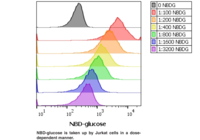 |
|
|
|
|
Glucose Colorimetric Assay Kit |
|
|
Code: 10009582. Glucose, a monosaccharide (or simple sugar), is the most important carbohydrate in biology. Transported via the blood stream, it is the primary source of energy for the body’s cells. Glucose level is tightly regulated in the human body. Failure to maintain blood glucose in the normal range leads to conditions of persistently high (hyperglycemia) or low (hypoglycemia) blood sugar. Diabetes mellitus, characterized by persistent hyperglycemia, is the most prominent disease related to failure of blood sugar regulation. Cayman’s Glucose Colorimetric Assay Kit provides a simple, reproducible, and sensitive tool for assaying glucose in plasma, serum, and urine. The glucose assay uses the glucose oxidase-peroxide reaction for the determination of glucose concentrations. In this assay, glucose is oxidized to d-gluconolactone with concomitant reduction of the flavin adenine dinucleotide (FAD)-dependent enzyme glucose oxidase. The reduced form of glucose oxidase is regenerated to its oxidized form by molecular oxygen to produce hydrogen peroxide. Finally, with horseradish peroxidase as a catalyst, hydrogen peroxide reacts with 3,5-dichloro-2-hydroxybenzenesulfonic acid and 4-aminoantipyrine to generate a pink dye with an optimal absorption at 514 nm. |
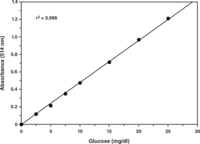 |
|
|
|
|
Glycolysis Cell-Based Assay Kit |
|
|
Code: 600450. Cayman’s Glycolysis Cell-Based Assay Kit provides a colorimetric method for detecting extracellular L-lactate, the end product of glycolysis, in cultured cells. In the assay, lactate dehydrogenase catalyzes the oxidation of lactate to pyruvate, in which the formed NADH reduces a tetrazolium substrate (INT) to a highly-colored formazan which absorbs strongly at 490-520 nm. The amount of formazan produced is proportional to the amount of lactate released into the culture medium and can be used as an indicator of the cellular glycolytic rate. This assay can be adapted to high-throughput screening for glycolysis regulators at the cellular level. Furthermore, the non-invasive sampling leaves the cells intact and thus allows multiplex testing for additional markers. |
 |
|
|
|
|
Glucose-6-Phosphate Fluorometric Assay Kit |
|
|
Code: 700750. Glucose-6-phosphate (G6P) plays a key role in the homeostatic regulation of blood glucose levels by participating in glycolysis, glycogen synthesis, gluconeogenesis, and can be metabolized to NADPH, enabling protection against oxidative damage. Disruption of G6P activity leads to glycogen storage disease type I or von Gierke’s disease, a group of inherited metabolic diseases characterized by severe hypoglycemia, growth retardation, and hepatomegaly, due to accumulation of glycogen and fat in the liver. Cayman’s Glucose-6-Phosphate Fluorometric Assay provides a fluorescence-based method for detecting G6P in tissue homogenates and cell culture samples. In the assay, G6PDH catalyzes the oxidation of G6P to 6-phospho-D-gluconate, along with the concomitant reduction of NADP+ to NADPH. NADPH reacts with the fluorometric detector to yield a highly fluorescent product which can be analyzed with an excitation wavelength of 530-540 nm and an emission wavelength of 585-595 nm. |
 |
|
|
|
|
Glucose-6-Phosphate Dehydrogenase Activity Assay Kit |
|
|
Code: 700300. Glucose-6-phosphate dehydrogenase (G6PDH) is a cytosolic enzyme that catalyzes the first step in the pentose phosphate pathway. This pathway includes converting glucose to ribose-5-phosphate, a precursor to RNA, DNA, ATP, CoA, NAD, and FAD. The pathway also generates NADPH. G6PDH deficiency, the most common enzyme deficiency worldwide, causes a spectrum of diseases including neonatal hyperbilirubinemia, acute hemolysis, and chronic hemolysis. G6PDH activity has been shown to be upregulated in rat and mouse models of obesity, hyperglycemia, and hyperinsulinemia. Cayman’s Glucose-6-Phosphate Dehydrogenase Assay provides a fluorescence-based method for detecting G6PDH activity in a variety of samples including erythrocyte lysates, tissue homogenates, and cell culture samples. |
 |
|
|
|
|
L-Lactate Assay Kit |
|
|
Code: 700510. L(+)-Lactate is the major stereoisomer of lactate formed in human intermediary metabolism. The lactate to pyruvate ratio reflects the redox state of the cell and describes the balance between NAD+ and NADH, which is dependent on the interconversion of lactate and pyruvate via lactate dehydrogenase (LDH). Monitoring lactate levels is, therefore, a good way to evaluate the balance between tissue oxygen demand and utilization and is useful when studying cellular and animal physiology. Cayman’s L-Lactate Assay provides a fluorescence-based method for detecting L-lactate in biological samples such as serum, plasma, blood, urine, and saliva. It can also be utilized to determine intracellular and extracellular lactate concentrations in cell culture samples. In the assay, lactate dehydrogenase catalyzes the oxidation of lactate to pyruvate, along with the concomitant reduction of NAD+ to NADH. NADH reacts with the fluorescent substrate to yield a highly fluorescent product. The fluorescent product is analyzed with an excitation wavelength of 530-540 nm and an emission wavelength of 585-595 nm. |
 |
|
|
|
|
Pyruvate Assay Kit |
|
|
Code: 700470. Pyruvate (pyruvic acid) is a key intermediate in cellular metabolic pathways and is derived primarily from glucose via glycolysis. Abnormal blood pyruvate levels are reported in a number of disorders including shock, liver disease, congestive heart failure, diabetes mellitus, thiamine deficiency, and metabolic disorders. Cayman’s Pyruvate Assay provides a fluorescence-based method for quantifying pyruvate in biological samples such as serum, plasma, blood, urine, and saliva. It can also be utilized to determine intracellular and extracellular pyruvate concentrations in cell culture samples. |
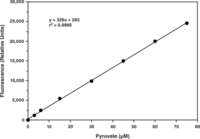 |
|
|
|
|
Glycogen Assay Kit |
|
|
Code: 700480. Glycogen is a polysaccharide that is the principal storage form of glucose in animal and human cells. Glycogen is made primarily by the liver and muscles, but it can also be made by glycogenesis within the brain and stomach. Cayman’s Glycogen Assay provides a simple, reproducible, and sensitive tool for assaying glycogen from tissue. In this assay, glycogen is hydrolyzed by amyloglucosidase to form ß-D-glucose, which is then specifically oxidized to D-glucono-d-lactone by glucose oxidase forming hydrogen peroxide in the process. Hydrogen peroxide, in the presence of horseradish peroxidase, reacts with 10-acetyl-3,7-dihydroxyphenoxazine (ADHP) in a 1:1 stoichiometry to generate the highly fluorescent product resorufin which is measure at an excitation wavelength of 530-540 nm and an emission wavelength of 585-595 nm. |
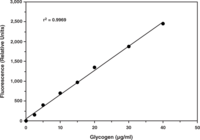 |
|
|
|
|
ATP Detection Assay Kit - Luminescence |
|
|
Code: 700410. Cayman's ATP Detection Assay Kit - Luminescence provides a simple and effective tool for measuring total ATP levels. This assay uses firefly luciferase to convert ATP and luciferin to oxyluciferin and light. The light emitted in this reaction is directly proportional to the concentration of ATP present. Using the ATP Detection Standard, quantitative measurement of ATP content can be achieved with a dynamic range of 12 fmol to 10 pmol of ATP. |
 |
|
|
|
|
|
|
|
Code: 705502. Aconitase is an iron-sulfur protein containing a [Fe4S4]2+ cluster that catalyzes the stereospecific isomerization of citrate to isocitrate via cis-aconitate. Whereas exposure of aconitase to oxidants renders the enzyme inactive, loss of aconitase activity in cells or in biological samples treated with pro-oxidants has been interpreted as a measure of oxidative damage. Cayman’s Aconitase Assay Kit provides a simple, reproducible, and sensitive tool for assaying aconitase from tissue homogenates or cell lysates. In this assay, citrate is isomerized by aconitase into isocitrate, which is then converted to a-ketoglutarate in a reaction catalyzed by isocitric dehydrogenase. These reactions are monitored by measuring the increase in absorbance at 340 nm associated with the formation of NADPH. The rate of NADPH production is proportional to aconitase activity.
|
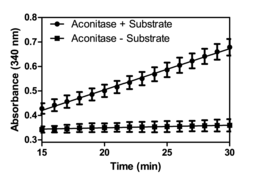 |
|
|
|